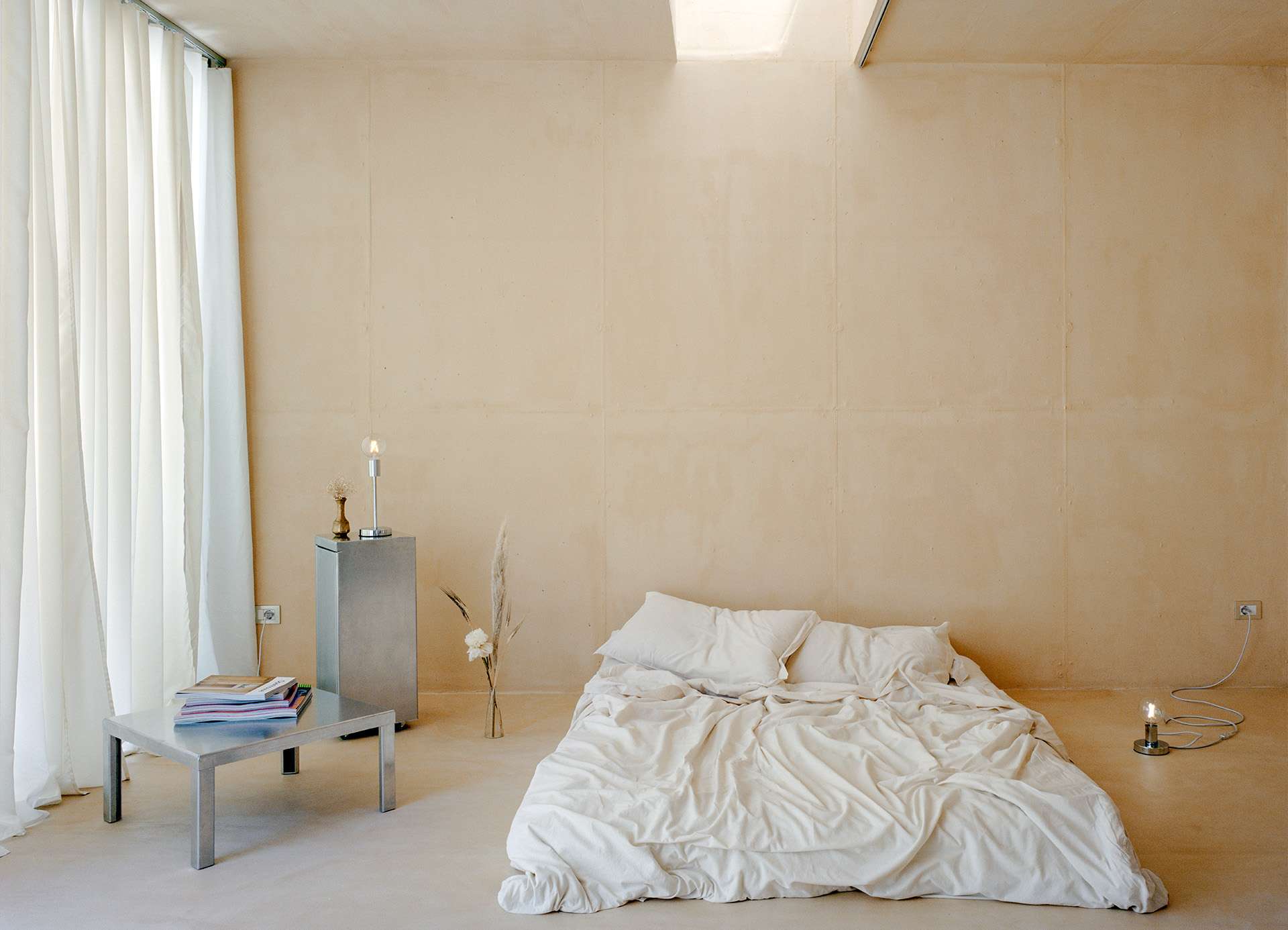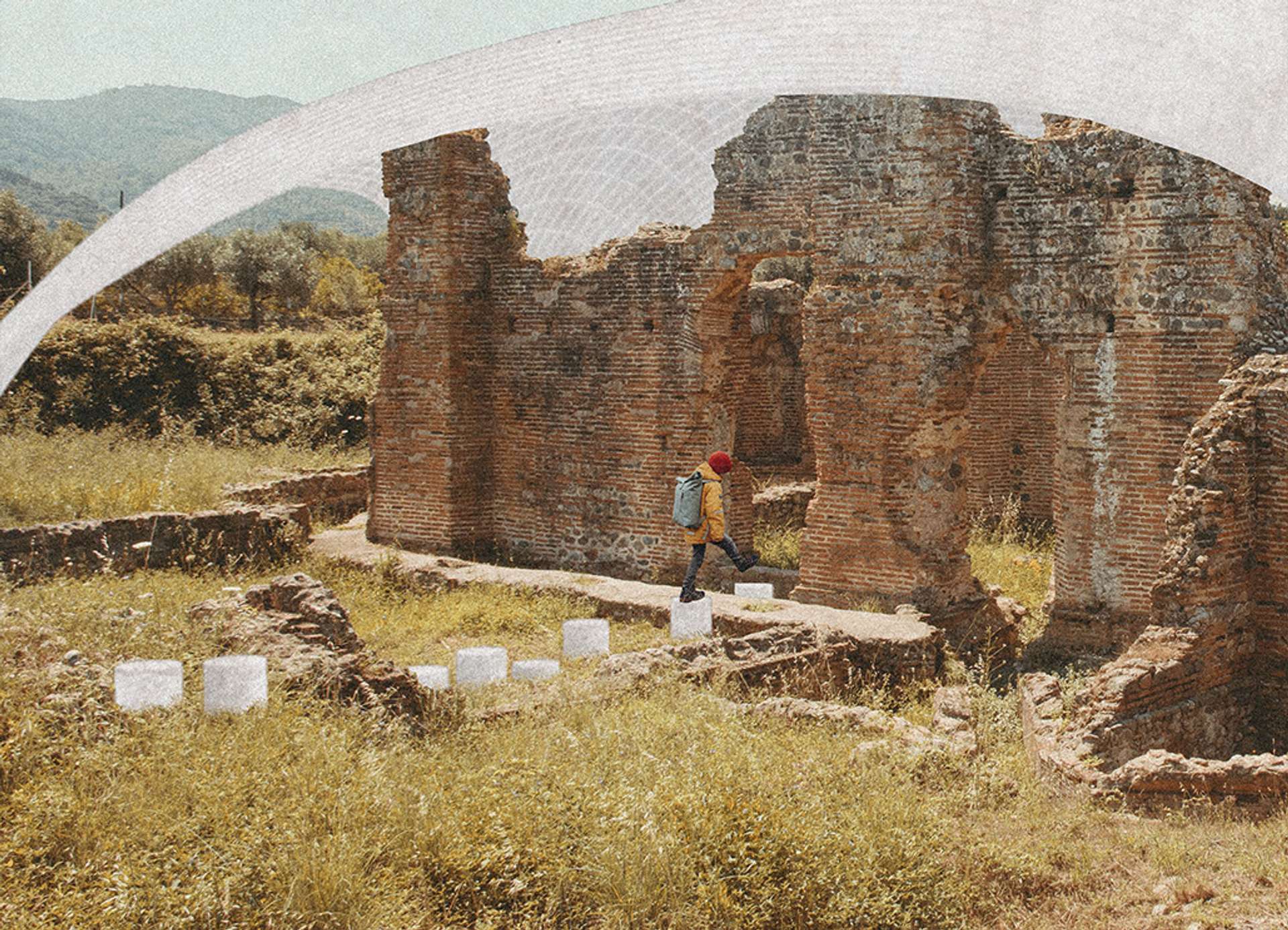Twenty years ago, the monumental and minimal artwork Wall was presented at the then-newly inaugurated Kunsthaus Graz, designed by Colin Fournier and former Archigrammer Peter Cook. Faithfully recreated in its original form, its impact and affect are nonetheless utterly new. We talked with curator Katrin Bucher Trantow, who worked on Sol LeWitt’s original Wall as well as its reinterpretation, arranged to mark the museum’s twentieth year.
KOOZ The installation — or restoration— of Sol LeWitt's Wall. Performed has been on view for several months now, after a twenty-year hiatus since its first staging in 2004. How has it been to live with and show this monumental work again?
KBT Yes, it has been a while — this installation opened in September last year. It's being seen by different publics — our building is also a tourist attraction in Graz, so we have a very mixed audience. As an institution celebrating its twentieth birthday, we're enjoying this a lot — it gives us the possibility to rethink how we act with works of art — even ephemeral works — and works that are meant to be enjoyed physically as well as in conceptual terms. The Wall acts in direct relation to its surroundings, and this feels poignant, because the perspective of twenty years allows us to consider the changing of history.
The Wall acts in direct relation to its surroundings, and this feels poignant, because the perspective of twenty years allows us to consider the changing of history.
KOOZ It has been an incredibly volatile couple of decades. To rewind: tell us how you experienced the piece in its original realisation in 2004.
KBT Actually, I was already a curator at the Kunsthaus — it was the first solo show we held at the museum. My former director had invited Sol LeWitt, who knew Graz and had friends here. He came to see the space while the building was erected and I was on site with him. We actually asked him to show his incomplete open cubes — as curators, we thought it would be interesting to have these works and the building as two endeavours of the late 1960s; two variants of a performative presence. The incomplete cubes with their modular concept of a seriality, and the performative architecture of the museum: both allowed for this feeling of movement, which we thought would be really interesting. He didn't dislike the proposal, but when he came to see the building he said he might have a different idea. Then he sent a fax with a drawing, saying he would like to build a wall.
We thought about how this right-angled object formed a different kind of movement in or through space; we saw it as a sculpture in a very conceptual and minimal way, or as a structure, as he would call it. It was a formal answer to the architecture. I have looked through the catalogue with other artists— artists whom we had invited to place work in in that space, which has no pillars, which is open and so on. Lots of them wanted to see the catalogue of Sol LeWitt; I think he laid out this idea of using the space directly. After a few years, we thought it was interesting that we had not considered all the different aspects of Wall — not only in terms of conceptual art, but somehow in terms of its geographical and political surroundings. As you might imagine, twenty years ago we didn’t talk about the wall being a manifestation of a border.
KOOZ It sounds like it was read more formally, metaphysically and of course experientially, with the body in space. From today’s perspective, it seems impossible to think of things without their political context, without social and even planetary implications...
KBT Well, it’s exactly the way you say it. When the ‘original’ Wall was still up, many visitors asked us what we would do with the artwork. Of course, that’s one of the questions with ephemeral work, usually — what will become of it. It wasn't really possible to put it on the market really — it was just too big, too monumental. Also, Sol was always motivated to pull his work out from the economic system of the art world. Only now revisiting the piece, it made sense to me that restaging was part of his thinking, in the background. He did offer the work to our sister museums; he even offered that we could keep it — not in the Kunsthaus itself, but maybe outside. But this would not have worked because it's made of porous material. To be honest, I think he was just open; he said “You do whatever you think is interesting”.
The material — which was a type of cement — was given back to the producer, and brought back into the building system. But we did secure permission to mount the work again one day.
KOOZ Personally I interpret that he always meant for the work to be ephemeral — such that perhaps it didn't matter if it was eaten by the elements.
KBT That is possible; I never really asked him that question. Eventually we decided to take it down; it was planned as a three-month work, after which we dismantled it — we just gave it back. The material — which was a type of cement — was given back to the producer, and brought back into the building system. But we did secure permission to mount the work again one day. LeWitt signed a contract to say that we can redo it on the basis of what we did originally. So for our twentieth birthday, we thought it would make sense to do just that.
We're now in the process of reflecting on what this means: this agreement to restage the work, it was always part of something we had as an ephemeral possibility, we weren’t collecting as such. We were just aware of a possible future where we would restage it.
KOOZ It's the concept that the museum held on to, rather than the physical work. But to recreate that work, inevitably, cannot be a recreation — it is something else, isn’t it?
KBT I think so. Again, it's about the idea. This situation allowed us to work with the idea and to come up with new ones. We are quite sure that Sol would enjoy what we're doing now — I was really pleased when I heard from his daughter and his wife, who gave us their blessing. We then started — of course, conceptually — with the idea and then talking about where it leads us. So we had this first chapter where the Wall was not yet standing but just acting as a possibility — of creating a space for Utopia, a space for ideas to be developed. We had John Baldessari Sings LeWitt in the space, which was beautiful because it added to this concept of time and a specific momentum.
KOOZ Momentum and a kind of resonance...
KBT Yes. The open space of Kunsthaus is an empty stage and we waited for the work to take shape. We created a workshop that we called Protocols for Utopia, where we invited different artists like the amazing Slovene filmmaker and performance artist Jasmina Cibic together with composer Barbara Kinga Majewska to work with us in the space. We held a long evening of reading and some beautiful choir performances — in the end, there were 200 people singing and thinking about these utopian protocols, reflecting on artists who had worked in the space over the last 20 years.
KOOZ At this point, the structure was not yet rebuilt, is that right?
KBT No, the structure was not there. After this gathering of ideas in space, the void actually had to be filled. After a few days, we started with the work, and also opened it up to the public; the build became a part of the piece. As you may know, Sol LeWitt was always interested in working with different people: with contractors, architects, engineers and so on. So the various parties started to produce the Wall and build it. It took us twelve days; the public was included in the sense that were able to become spectators of this performative aspect of producing the work itself — that became a part of this piece. Twenty years later, it felt right to open that up as well.
Perhaps before we were not able to speak about that, because it felt like it could disrupt the existential or even the spiritual aspects in the work itself. Now, we're very interested in these aspects of collaboration, of multiple authorship.
KOOZ The reasons we go to museums or galleries as visitors, and how such places are dialoguing with new audiences and publics, have also changed since the time of the original, right?
KBT If you read his sentences on conceptual art, there are these sentences, and also the work of art. They are both there. I guess it is — as you were saying — this feeling of the existential in his work as well as the literal, like reading the Wall for what it is, though it's also a separation, it could be a monument to the border. Perhaps before we were not able to speak about that, because it felt like it could disrupt the existential or even the spiritual aspects in the work itself. Now, we're very interested in these aspects of collaboration, of multiple authorship. So yes, I think it is very much of our time that we look at these aspects of production as well.
KOOZ The opportunity to revisit perhaps allows for a… less 'sacred' approach to the Wall — a more dynamic and critical interaction with the idea itself, with less reverence, perhaps, for themetaphysical purity of it..
KBT I absolutely agree. I think that's exactly what work is, but it's also a danger if you don't look at all these aspects like borders or separations, the political constructs. If you present this very aloof work that is purely metaphysical, perhaps it could become pure beauty. But that wasn't all that Sol was interested in, I think. Beauty also, but not only. At the same time, I do not think he would not have wanted us to present it as a symbol of division: this would, I think, be far too much. But if it is other artists who come up with associations, then I think that was something that he would have agreed with; he was always keen to invite other artists to work in the space that he had created. So it is not us saying that this is a piece about borders. I still have this feeling that you shouldn't try to define too much, you can only look for different readings.
I still have this feeling that you shouldn't try to define too much, you can only look for different readings.
KOOZ So rather than imposing a new set of meanings, it’s about opening it to interpretation and response. Tell me about some of the other artists who have added their interpretations.
KBT The first artist that we invited is an Austrian painter, Franz Vana. He also works with this idea of modular structures; he works with words and word combinations, as if words were actually the stones with which to build. By placing his works across from the Wall, in a mirror-like situation, his paintings were reflected in the silence of the Wall, in a way. It’s muteness versus the ‘talkative’ works of Franz Vana, like a counterpart or adversary in a sense. It’s not entirely possible to look at the Wall in one glance: if you enter the space, you cannot see the whole thing, it’s quite impossible. You have to walk around it to actually understand it. I had the impression that Vana was doing something similar: with over 120 paintings, he was opening up this impossibility of actually understanding anything in one go.
Local artist Helene Thümmel has run several workshops on collaboration, and we are currently showing the artist Renate Krammer, who was working on the idea of creating a line and leaving signs; she draws attention to the closeness of Sol's structures to his drawings. Usually the structures come from drawing, starting with the line and Renate is now working on different possibilities of lines, lines on paper, possibilities of actually drawing a sign, but also crossing out something that has been there before so it's between erasure and creation. Again, sort of reflecting itself associatively in the Wall itself.
After Renate, we have invited the artist Alicja Kwade from Berlin, who is showing her recent work dealing with gravitation, with gravity, and with the solidity of stone. Playing with this in relation to size, but also to time, her work comments on planetary systems; she creates these fantastic globes that are very heavy, made out of marble. I am looking forward to talking about the aspect of time that we feel in the Wall.
The last large installation will be by Gabriela Golder, an Argentinian artist; we have invited her to bring a work that is called Letters, in which she reflects on the idea of storing memory and how to create relationships over borders. In this work, letters are read by children who have received them from imprisoned relatives. It's about bridging and creating relationships but it's also about shared and stored memories in these Letters.
KOOZ That's beautiful. The idea of something that can transcend such a massive physical object is a beautiful way to end.
KBT I had this memory that was very strong: once the Wall was up, there were these two distinct spaces that were created. If you walk along the outside of the Wall, you immediately lose sense of time and space because you are in this relatively small corridor; you lose your relation to the outside world in this womb-like situation. I have asked the public how they feel about the Wall — a lot of people say that they like it, that it's not aggressive in any way, that it's very silent. A lot of people drift to the inside immediately. Of course, there is always the aspect of keeping certain things out but also gathering things in. Children have this tendency of using the space freely — because it's still quite a big space, 250 square metres on the inside, so they run around. For me, probably the most beautiful moment was when a group of young-ish people went inside the space and spontaneously began to sing, because it has this fantastic acoustic quality.
KOOZ I have had a similar feeling of seeing massive structure as a companion, for example with Serra. Or even at home, I sleep close to the wall. So, if you had to distil what's different about the response and the mounting of the wall this year — what imaginaries does this conjure now?
KBT I think — very simply, actually — it's this idea of temporality. This time round, it feels like the moment we had built it, there was a melancholy in the space where people already knew it's going to go — you feel this is not forever. This might have happened because we are already telling them that it is the second time and we might not do it again.
Twenty years ago, when we looked at the wall, there was certainty, but today we are more aware of this fragility — maybe that’s another interpretation.
The first time around, people did ask where the artwork will go but it didn't have this melancholic aspect. Rather, there were economic questions: 'What will happen to the Wall? Can it be stored? Do you have a Sol LeWitt now?'. This time, Wall. Performed has felt like opening up multifaceted aspects of the original — creating it as this productive Other. The sense of melancholy is maybe also due to the time that we're in; we feel things are crumbling, and there is no sense of certainty. Twenty years ago, when we looked at the wall, there was certainty, but today we are more aware of this fragility — maybe that’s another interpretation.
KOOZ Right now we engage so much with the ephemeral. I was trying to recall a book that I'd seen on social media; I hadn't saved the post and now there's no way that I can find it. There are so many tiny losses, little intimacies, ephemeral conversations; when you have a relationship to a monumental wall, there must be a grieving for its imminent loss.
KBT Indeed. Thanks so much for also asking these questions; it's always good for us to reflect on what we're doing, and it was lovely to talk about it.





